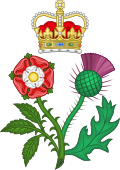Parliament of Great Britain
Parliament of the Kingdom of Great Britain | |
|---|---|
First-past-the-post with limited suffrage | |
| Meeting place | |
 | |
| Palace of Westminster, London | |
| Footnotes | |
| See also: Parliament of Ireland |
The Parliament of Great Britain was formed in May 1707 following the ratification of the Acts of Union by both the Parliament of England and the Parliament of Scotland. The Acts ratified the treaty of Union which created a new unified Kingdom of Great Britain and created the parliament of Great Britain located in the former home of the English parliament in the Palace of Westminster, near the City of London. This lasted nearly a century, until the Acts of Union 1800 merged the separate British and Irish Parliaments into a single Parliament of the United Kingdom with effect from 1 January 1801.
History
Following the Treaty of Union in 1706, Acts of Union ratifying the Treaty were passed in both the Parliament of England and the Parliament of Scotland, which created a new Kingdom of Great Britain.[1][2] The Acts paved the way for the enactment of the treaty of Union which created a new parliament, referred to as the 'Parliament of Great Britain', based in the home of the former English parliament. All of the traditions, procedures, and standing orders of the English parliament were retained, although there is no provision for this within the treaty; furthermore, the incumbent officers and members representing England comprised the overwhelming majority of the new body. It was not even considered necessary to hold a new general election. While Scots law and Scottish legislation remained separate, new legislation was thereafter to be enacted by the new parliament, with the exception of that pertaining to private right which could only legislated on for the "evident utility" of the people.[3] England's de facto prominence in the new parliament was, and remains, a contentious issue.[citation needed]
After the
George II's successor,
During the first half of George III's reign, the monarch still had considerable influence over Parliament, which itself was dominated by the patronage and influence of the English nobility. Most candidates for the House of Commons were identified as
The
In the wake of the
Parliament of the United Kingdom
In 1801, the Parliament of the United Kingdom was created when the Kingdom of Great Britain was united with the Kingdom of Ireland to become the United Kingdom of Great Britain and Ireland under the Acts of Union 1800.
Membership by constituent country
Monmouthshire (One County constituency with two members and one single member Borough constituency) is included in Wales in these tables. Sources for this period may include the county in England.
Table 1: Constituencies and Members, by type and country[5]
| Country | BC | CC | UC | Total C | BMP | CMP | UMP | Total Members | Population (1700) | People per MP |
|---|---|---|---|---|---|---|---|---|---|---|
| 202 | 39 | 2 | 243 | 404 | 78 | 4 | 486 | 5.1 million[6] | ~10,500 | |
| Wales | 13 | 13 | 0 | 26 | 13 | 14 | 0 | 27 | 400,000[6] | ~21,000 |
| 15 | 30 | 0 | 45 | 15 | 30 | 0 | 45 | 1 million[7] | ~22,000 | |
| Total | 230 | 82 | 2 | 314 | 432 | 122 | 4 | 558 | 6.5 million | ~12,000 |
Table 2: Number of seats per constituency, by type and country
| Country | BC×1 | BC×2 | BC×4 | CC×1 | CC×2 | UC×2 | Total C |
|---|---|---|---|---|---|---|---|
| 4 | 196 | 2 | 0 | 39 | 2 | 243 | |
| Wales | 13 | 0 | 0 | 12 | 1 | 0 | 26 |
| 15 | 0 | 0 | 30 | 0 | 0 | 45 | |
| Total | 32 | 196 | 2 | 42 | 40 | 2 | 314 |
See also


- List of acts of the Parliament of Great Britain
- List of parliaments of Great Britain
- List of speakers of the British House of Commons
- Parliament of Ireland
- Members of the Parliament of Great Britain
References
- ^ "Uniting the kingdom?". The National Archives. Archived from the original on 6 February 2011. Retrieved 18 January 2011.
- ^ "Making the Act of Union 1707" (PDF). Scottish Parliament. Archived from the original (PDF) on 11 May 2011. Retrieved 18 January 2011.
- ^ Act of Union 1707, Article 1
- ISBN 0-521-83331-0.
- ^ British Historical Facts 1760–1830, by Chris Cook and John Stevenson (The Macmillan Press 1980).
- ^ a b Marshall, John (25 August 1838). "A Geographical and Statistical Display ... of Each Country ... of the British Empire ...: With a Like Display ... of the Several Provinces and Districts of Russia, Prussia, France, the Netherlands, Germany" – via Google Books.
- ^ "History of the Union - Part two: 1707 - 1783". www.telegraph.co.uk. 11 December 2007.
External links

